The Best Arm Exercises For All Levels Of Gym-Goer
Build bigger, stronger arms with these beginner, intermediate and advanced exercises
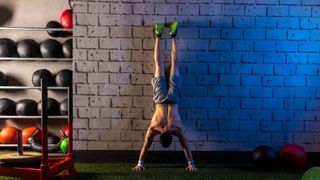
While the arms are not an area of the body many of us neglect in the gym – who doesn’t want bigger arms? – all too often people’s repertoire of arm exercises doesn’t extend far beyond biceps curls.
That’s an issue if you want to add strength or size to your arms, if only because it’s the triceps that actually make up the bulk of your upper arms. To fill up your arm exercise playbook, we enlisted Mila Lazar, head of HIIT at boutique gym Another_Space, and Keith McNiven, founder of personal training company Right Path Fitness, for advice.
“Working your arms doesn’t have to involve a ton of equipment, or be a laborious task,” says Lazar. “Not only will the moves below give you more defined arms, but they also work various other muscle groups at the same time.”
Here, Lazar and McNiven detail their picks of the best arm exercises for beginner, intermediate and advanced gym-goers, and we throw in a few of our favourites, too.
Beginner Arm Exercises
Dumbbell overhead triceps extension
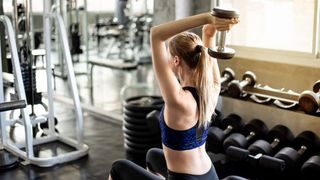
“This is a simple move that really isolates your triceps muscles,” says Lazar. “Hold a dumbbell in both hands and lift it above your head until your arms are fully extended. Lower the dumbbell behind your head by bending your elbows, and then return back to the fully extended position.”
Standing biceps curl

“Hold a dumbbell in each hand, keeping your elbows in line with your torso,” says Lazar. “Curl the weights up towards your shoulders, then back down towards your hips.”
Dumbbell overhead press

“I always include the overhead press in my training because it strengthens joints as well as improving your upper-body strength,” says Lazar. “Hold two dumbbells at head height with your elbows bent at a 90° angle. Press the dumbbells above your head, fully extending your arms.”
Get the Coach Newsletter
Sign up for workout ideas, training advice, reviews of the latest gear and more.
Kettlebell halo
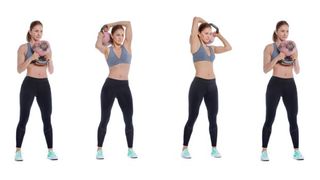
The kettlebell halo is a great beginner exercise because it doesn’t matter who you are, you have to use a light weight – it’s murder on the arms. That means you won’t (hopefully) be tempted to overdo it when perusing the kettlebell rack.
Taking a firm grip on the handles of the light kettlebell you’ve chosen, raise it until it’s in front of your face with the handles pointing away from you. Slowly rotate the bell around your head. Change the angle of the kettlebell as you rotate but not your grip. Go at a slow pace and watch out for your head. One lap around the noggin is a rep. Aim for five rotations in one direction, then do the same number the other way.
Intermediate Arm Exercises
Triceps dip
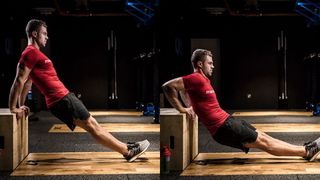
“If you’re at the gym find a bench for this exercise,” says McNiven. “And if you’re at home or outdoors, a chair or park bench will work equally well.
“Grip the edge of the bench. Your legs should be out in front of you, with your knees bent at around 90°. Slowly lower yourself using your triceps muscles until your elbows are bent at around 90°, then come back up to full extension. As you progress, straighten the legs as this means more work for your triceps.”
Press-up
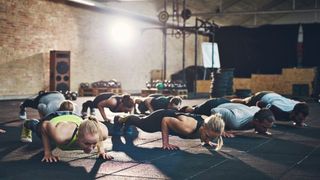
“The press-up might seem like a boring move, but it’s a great one for working multiple muscle groups at the same time, and it also builds core strength”, says Lazar. “Start on all fours with your hands directly under your shoulders and arms extended, and legs straight supporting your weight on your toes. Lower your chest to the ground, then push back up.”
Front raise to lateral raise
“Hold two dumbbells at your sides, palms facing you, and stand with your feet shoulder-width apart,” says Lazar. “With your elbows slightly bent, raise the dumbbells to shoulder height in front of you and lower them again. Then raise them to shoulder height out to your sides. Continue to alternate between front and side (lateral) raises.”
Zottman curl
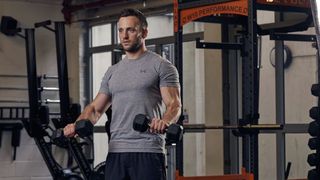
Another standing curl, but one that hits a wider range of muscles than the traditional biceps curl. Not only do you work the biceps from more angles with the Zottman variation, but you will also increase your forearm strength. That forearm strength will translate into a powerful grip, which aids in all manner of lifts as well as giving you a powerhouse of a handshake.
To perform the Zottman curl hold a pair of dumbbells by your sides with your palms facing. Curl the weights up to your shoulders slowly, twisting your wrists so your palms face you by the time you reach the top of the movement. Turn your wrists again so that your palms are facing down, then slowly lower the weights.
Chin-up
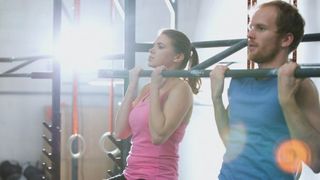
It’s hard to find a bodyweight exercise that works your biceps as well as the chin-up, and the improvements it’ll make to your grip strength will also help when it comes to free-weight work. Grasp a pull-up bar with your hands shoulder-width apart, your palms facing you and arms fully extended. Pull yourself up until your chin is level with the bar. Pause and squeeze your biceps – the increased blood flow will improve growth – then lower under control. Aim for three sets of four, but make sure each rep is slow and controlled.
Concentration curl
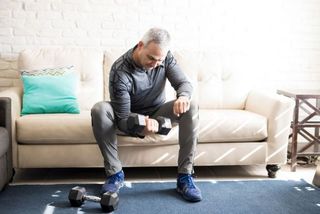
Done correctly, the biceps curl is a brilliantly effective way to bulk up your upper arms, but it’s also a move where it’s very easy to cheat a little – a small sway during the exercise can go a long way in creating momentum, which reduces the load on your arms. The concentration curl is a variation that eliminates this possibility – the position and pace of the move ensure you keep the focus on your biceps throughout.
Sit on a bench set to a height where your knees are bent at 90° with your feet flat on the floor. Hold a dumbbell in your right hand and lean forwards so your arm is hanging down and the back of your upper arm is against the inside of your right thigh. Slowly curl the weight up, moving only your forearm – the position of your arm against your thigh will help with this. Pause at the top and squeeze your biceps, then slowly lower back to the start. Do all your reps on one arm, then switch.
Battle rope wave
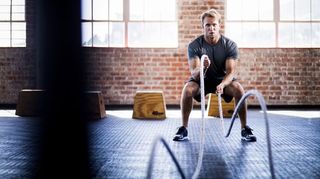
It’s a move that just looks good, which is lucky because that fact makes you temporarily forget how quickly battle rope waves become a battle just to keep going. Persevere, however, and they’ll contribute to outstanding biceps and get your heart rate rocketing. They’re mainly about pure intensity, which means they make for a great intermediate exercise.
Grab a rope in each hand and lower into a squat. Raise one arm fast and with force up to shoulder or head height. As you slam that rope down, bring the other up – neither arm should rest until the set is over. Keep alternating the slams as fast as you can, although you should pace yourself to whatever work period you’ve chosen.
Because of the seriously high rep counts, work in 30-second to one-minute bursts for a total time of five to ten minutes.
Spider curl
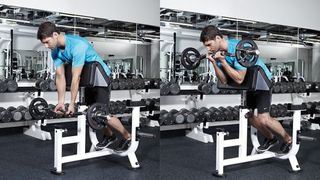
This biceps curl variation allows for a greater range of motion and keeps the muscles under tension for a longer period, making it an effective move for anyone seeking to add bulk to their upper arms. You’ll need a barbell or EZ-bar and a bench set at a 45° angle.
Lie face down on the bench with your feet on the floor, and hold the bar under you with your palms facing up. Slowly curl the bar up, pause for a second at the top of the move, then lower it under control. Having your arms hanging down is what gives you the larger range of motion, but it also makes it easy to cheat and use other muscles and momentum, so make sure you’re only moving your forearms and perform the move slowly and deliberately.
Zercher carry
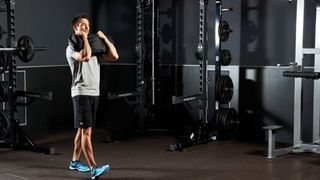
The epitome of a functional exercise, the Zercher carry will make you good at carrying things in front of you, whether that’s inside or outside of the gym. It’s great for your core strength and also works the biceps, forearms and shoulders.
First you need to find an appropriate weight – a sandbag or log is ideal, or you can use a normal barbell with pads. Set up your weight off the ground in front of you so you can pick it up, just below elbow height. Bend your knees to lower into a squat and cradle the weight in your elbow crease. Drive up to standing and walk a set distance, ensuring that the weight is in your arms. Turn around, walk back and put the weight back down.
See related
- The Biceps Exercises You Need To Get Bigger Biceps
- The Best Triceps Exercises For All Levels Of Gym-Goer
- Fill Your Sleeves With This Tri-Set Arms Workout
Advanced Arm Exercises
Ring dip
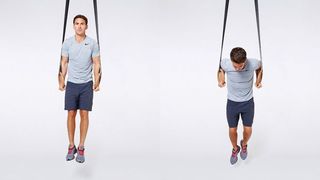
“Start by adjusting the height of the rings so your feet won’t touch the ground between reps,” says McNiven. “Mount the rings and get in a support position – you should be above the rings with your arms straight and supporting your bodyweight. Lower your body in a controlled manner, keeping your arms close to your sides, then press back up to the support position.”
Close-grip triceps press-up
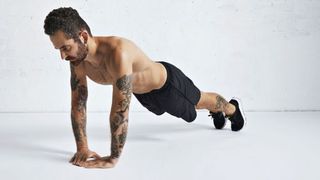
One of the most popular variations on the press-up, the close-grip or diamond press-up shifts the emphasis to the triceps, while still working the shoulders and chest. “I love the triceps press-up because it really challenges your arms to work a bit harder, while also engaging your core,” says Lazar. “Get into a press-up position but place your hands closer than shoulder-width apart under your chest. Lower yourself until your chest just touches the ground, then push back up.” This version is harder than the standard move, so don’t be surprised if you can’t do as many reps.
Handstand press-up

“The handstand press-up is another move that really pushes your arms a bit further than the traditional press-up,” says Lazar, “and it is also great for increasing stability and balance – plus it’s fun to do! Kick your feet up so you are in a handstand position against a wall and bend your arms to lower yourself as far as possible, then push back up.”
Barbell front raise
“Holding a barbell with your hands shoulder-width apart, allow your arms to hang straight down to mid-thigh height,” says Lazar. “Raise the bar straight out in front of you with your arms extended until it reaches shoulder height, then slowly lower it back to the starting position.”
Close-grip chin-up
Move your hands close together for this chin-up variation, which places even more emphasis on the biceps than the standard chin-up. Focus on really squeezing the biceps at the top of the move, then lower slowly.
Bench press

The mighty bench press may be a chest-day staple, but as a compound exercise it also makes demands on your arms – mainly your triceps. Load up a barbell with a weight you can move for approximately three sets of eight reps, getting close to exhaustion for the last set (make sure you have a spotter for that final set). Lie on a bench and hold the barbell with hands slightly wider than shoulder-width apart and your palms facing away from you. Unrack the bar and slowly lower it – aim to take three seconds. When your elbows are bent at 90° and the bar is close to your chest, pause and then press the barbell up powerfully.
Round the world pull-up
This is a serious upper-body exercise that will heat your forearms up. Grasp a pull-up bar using an overhand grip with your hands wider than shoulder-width apart. As you pull up, move your body to one side and then back to centre as you reach the top of the move. Move your body slowly and under control to the other side as you lower. Aim for one or two going clockwise and the same going anticlockwise. Your rep target should be low, especially when you’re just starting out, but remember to work both ways equally – the last thing you want is to build muscle imbalances.

Nick Harris-Fry is a journalist who has been covering health and fitness since 2015. Nick is an avid runner, covering 70-110km a week, which gives him ample opportunity to test a wide range of running shoes and running gear. He is also the chief tester for fitness trackers and running watches, treadmills and exercise bikes, and workout headphones.
- Jake StonesContributor
